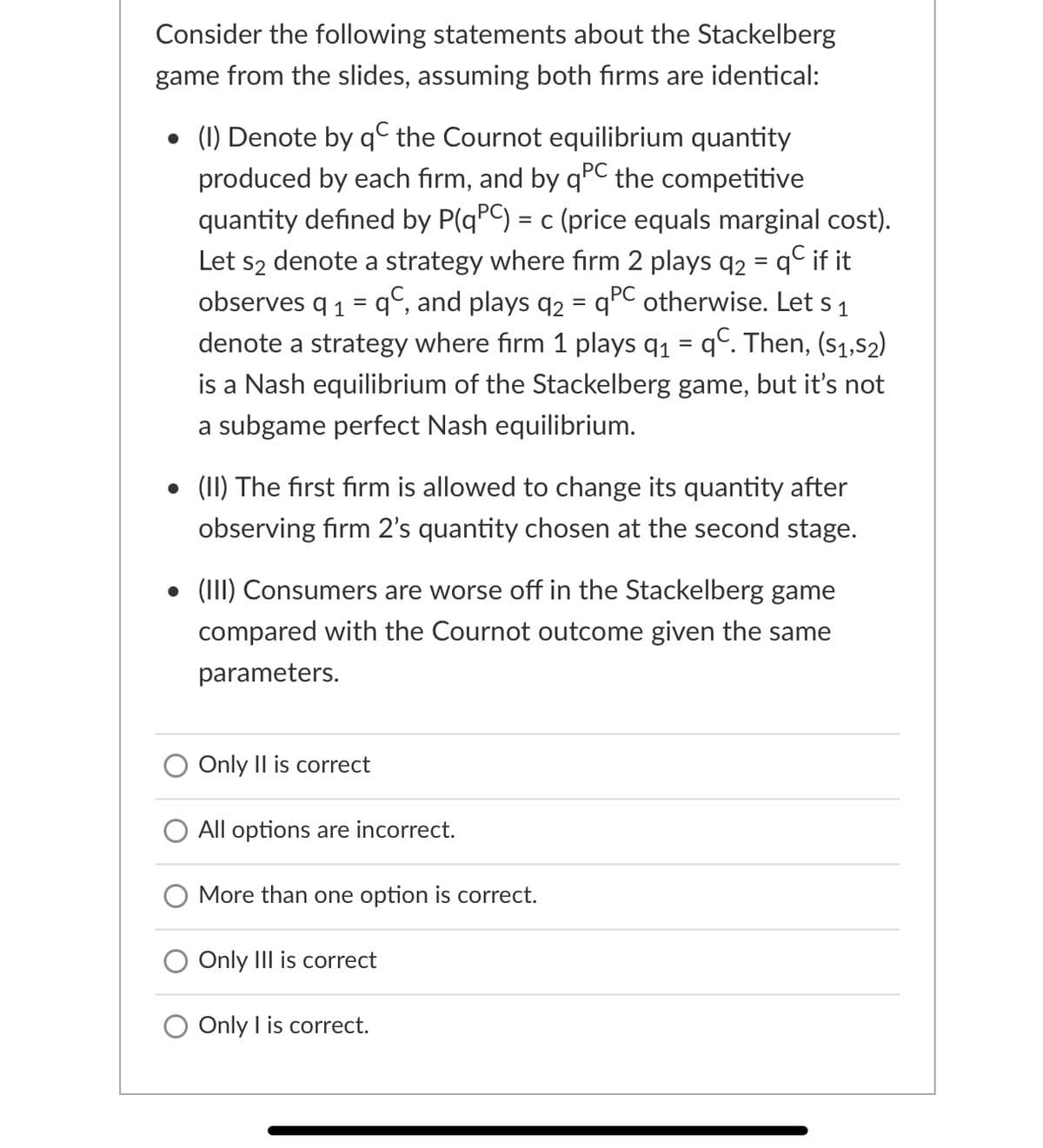Consider the following statements about the Stackelberg game from the slides, assuming both firms are identical: • (1) Denote by qº the Cournot equilibrium quantity produced by each firm, and by q°C the competitive quantity defined by P(qPC) = c (price equals marginal cost). Let s2 denote a strategy where firm 2 plays q2 = q° if it %3D %3D observes g 1 = gC, and plays gɔ = a 1 = gC. and plays gɔ = gPC otherwise, Let s 1
Consider the following statements about the Stackelberg game from the slides, assuming both firms are identical: • (1) Denote by qº the Cournot equilibrium quantity produced by each firm, and by q°C the competitive quantity defined by P(qPC) = c (price equals marginal cost). Let s2 denote a strategy where firm 2 plays q2 = q° if it %3D %3D observes g 1 = gC, and plays gɔ = a 1 = gC. and plays gɔ = gPC otherwise, Let s 1
Chapter15: Imperfect Competition
Section: Chapter Questions
Problem 15.3P
Related questions
Question
Q5

Transcribed Image Text:Consider the following statements about the Stackelberg
game from the slides, assuming both firms are identical:
• (1) Denote by q© the Cournot equilibrium quantity
produced by each firm, and by qºC
quantity defined by P(qPC) = c (price equals marginal cost).
Let s2 denote a strategy where fırm 2 plays q2 = q° if it
observes q 1 = q°, and plays q2 = qPC otherwise. Let s 1
the competitive
%3D
denote a strategy where firm 1 plays q1 = q°. Then, (s1,52)
is a Nash equilibrium of the Stackelberg game, but it's not
a subgame perfect Nash equilibrium.
• (II) The first firm is allowed to change its quantity after
observing firm 2's quantity chosen at the second stage.
• (III) Consumers are worse off in the Stackelberg game
compared with the Cournot outcome given the same
parameters.
Only Il is correct
All options are incorrect.
O More than one option is correct.
O Only IIl is correct
O Only I is correct.
Expert Solution
Step 1
Cournot Model Outcomes -
Output of each firm = qc
Strategy (s1 , s2 ) => If , q1 = qc , then q2 = qc
If , q1 /= qc , then q2 = qpc
Step by step
Solved in 2 steps

Knowledge Booster
Learn more about
Need a deep-dive on the concept behind this application? Look no further. Learn more about this topic, economics and related others by exploring similar questions and additional content below.Recommended textbooks for you


Managerial Economics: Applications, Strategies an…
Economics
ISBN:
9781305506381
Author:
James R. McGuigan, R. Charles Moyer, Frederick H.deB. Harris
Publisher:
Cengage Learning

Survey of Economics (MindTap Course List)
Economics
ISBN:
9781305260948
Author:
Irvin B. Tucker
Publisher:
Cengage Learning


Managerial Economics: Applications, Strategies an…
Economics
ISBN:
9781305506381
Author:
James R. McGuigan, R. Charles Moyer, Frederick H.deB. Harris
Publisher:
Cengage Learning

Survey of Economics (MindTap Course List)
Economics
ISBN:
9781305260948
Author:
Irvin B. Tucker
Publisher:
Cengage Learning

